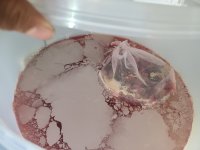Shenanigans
Well-Known Member
A bit off topic but I brewed a kettle sour with SourPitch and 50% pils 50% wheat over the weekend.
I soured it for about 45 hours at 35oC.
I also added a table spoon of lactic acid to get the PH down before adding the SourPitch - no exact science or PH meter but the PH should have been around 4.2
It tasted much different than when done for a week at 19oC and no acid.
Very lemony as described on the manufacturer website.
I added 15g salt , 20g Corriander and 60g Tradition hops at the start of a 15 min boil.
I got 23 Litres of 1.048 wort with 12 IBUs and am fermenting it with M21 Witbier yeast.
Hopefully it will be a refreshing Summer drink around 5%.

I soured it for about 45 hours at 35oC.
I also added a table spoon of lactic acid to get the PH down before adding the SourPitch - no exact science or PH meter but the PH should have been around 4.2
It tasted much different than when done for a week at 19oC and no acid.
Very lemony as described on the manufacturer website.
I added 15g salt , 20g Corriander and 60g Tradition hops at the start of a 15 min boil.
I got 23 Litres of 1.048 wort with 12 IBUs and am fermenting it with M21 Witbier yeast.
Hopefully it will be a refreshing Summer drink around 5%.






















![Craft A Brew - Safale S-04 Dry Yeast - Fermentis - English Ale Dry Yeast - For English and American Ales and Hard Apple Ciders - Ingredients for Home Brewing - Beer Making Supplies - [1 Pack]](https://m.media-amazon.com/images/I/41fVGNh6JfL._SL500_.jpg)





































